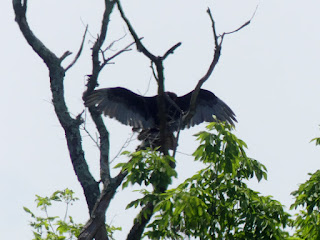Turkey Vultures
Here are 2 different looks at Turkey Vultures.
When you see them without their wings spread, Turkey Vultures can fool you into thinking their plumage is all black, but when they open them up (or you see them soaring overhead) you can see that's not really true. Seeing them from below you can easily see the feathers at the end of their wings (flight feathers) are much lighter than the near-black plumage we see when the wings are closed. Although many times those light-colored flight feathers look more like a light gray rather than the near-white color in this picture, I'm not sure how much this is due to individual variance and how much is due to the lighting. But this pattern where the flight feathers are much lighter than the rest of the wings is an excellent indicator of a Turkey Vulture (not a Bald Eagle).
 | ||
| May 18, 2023 at Fairview Farm Photo 292810623, (c) jpviolette, some rights reserved (CC BY-NC) |
Here's another Turkey Vulture where the flight feathers look darker, though (maybe with a little imagination) be able to detect that the flight feathers are lighter than the rest of the wings. This vulture also appears to be missing some of its flight feathers. My understanding is that Turkey Vultures are supposed to do a long, slow molt, molting the flight feathers in sequence, and shouldn't be missing more than 1-3 flight feathers at any point in time, though this individual seems to have more missing and/or short flight feathers than I'd expect. Note that the head doesn't appear to be red, suggesting this Turkey Vulture might be under a year old. It's possible that its unusual molting is something that juvenile Turkey Vultures have to go through.
 |
| May 18, 2023 at Willowwood Arboretum Photo 292812552, (c) jpviolette, some rights reserved (CC BY-NC) |



Comments
Post a Comment